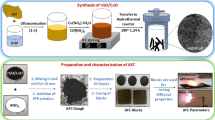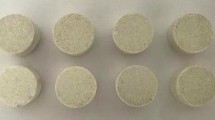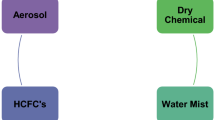Abstract
Pyrotechnic mixtures can produce aerosol fire extinguishing agent by combustion and serve as an efficient and economic alternative to the halons. In this work, magnesium powder was used as an additive to improve the combustion performance of the strontium nitrate-based pyrotechnic aerosol fire extinguishing agent. Optimization was carried out regarding extinguishing time, residue mass, combustion temperature, corrosiveness, combustion product and mass burning rate. Even though magnesium powder is a high energy combustion agent, the results showed that the flame temperature could be controlled within a reasonable range of 700°C to 900°C by proper formulation, and the performance of the strontium nitrate-based aerosol fire extinguishing agent can be improved efficiently.
Similar content being viewed by others
Explore related subjects
Discover the latest articles, news and stories from top researchers in related subjects.Avoid common mistakes on your manuscript.
1 Introduction
Halon has been banned in most countries as fire extinguishing agent due to its negative impact on the ozone layer. Consequently, there has been active research for halon replacements [1, 2]. Among the replacement materials, pyrotechnic aerosol fire extinguishing agent has received increasing attention because it is efficient, economic and easy to maintain [3]. Aerosol contains a large number of particles that can absorb heat from the flame and undergo chemical reaction to inhibit or weaken the flame intensity. The particle size of aerosol ranges in 0.001 μm to −1 μm, which gives it huge surface area and consequently excellent fire-fighting performance. Another advantage of aerosol fire extinguishing agent is that its particles follow Brownian motion to achieve total flooding fire suppression [4], which makes it widely applicable in various relatively closed environments such as aircraft, ship, combat vehicle, etc. [5, 6]. The pyrotechnic aerosol fire extinguishing agent consists of the oxidant, the flammable agent, the adhesive and the additives, which are evenly mixed and granulated to form the extinguishing agent. Upon combustion, these components can form aerosol to enable fire extinguishing. The K-type aerosol fire extinguishing agent uses potassium nitrate as the oxidant. However, the combustion products of potassium nitrate are corrosive to most metals, and strontium nitrate has been used as an alternative oxidant of potassium nitrate to give S-type aerosol fire extinguishing agent [7, 8]. Table 1 compares the properties of potassium nitrate and strontium nitrate.
It was previously noted [8] that the S-type aerosol has better explosion suppression effect than the K-type aerosol. However, the utility of S-type fire extinguishing agent is limited by its unstable combustion and poor ignition performance, due to its higher decomposition temperature. The other question is what is too slow to meet the time requirement to put out fires. In this work, we explore the use of magnesium powder to improve the combustion performance of the S-type aerosol fire extinguishing agent.
2 Optimization of Formulation
First of all, orthogonal experiments were carried out to select the additives for the formulations. Using a constant composition of magnesium powder (5%), lactose (25%) and strontium nitrate (45%), four candidate functional additives (nitrocellulose, phenolic resin, urotropine and ureophil) were tested by orthogonal experiments, considering the combustion time, extinguishing time, residual mass and mass burning rate as the optimization criteria. Based on the test results, nitrocellulose and phenolic resin were selected as the additives. Therefore, the tested pyrotechnic extinguishing agents consisted of magnesium powder, lactose, strontium nitrate, nitrocellulose and phenolic resin. Herein the combustible agents include magnesium powder and lactose. Magnesium powder was added as a modified combustible agent that ensures reliable ignition and stable combustion. Lactose was used as a regulator to prevent the combustion temperature from getting too high. Strontium nitrate was the oxidizer and nitrocellulose was a functional additive to guarantee continuous burning. Phenolic resin is a dry powder and was used as the adhesive.
Because the addition of magnesium powder inevitably increases the combustion temperature, the amount of magnesium powder is a very important consideration. Hence, the optimal content of magnesium powder was determined next by varying the contents of lactose and magnesium powder in the formulation while maintaining their total content at 30% (see Table 2). In order to determine the combustion stability, the flame temperature was measured directly in the burning tower. The burning tower is made of an iron pipe standing on the ground. It has an inner diameter of 80 cm and is 200 cm high. A square window (40 cm × 40 cm) on the side of the iron pipe can be opened for observing the combustion and putting in the sample. The top of the burning tower connects a ventilation system.
The pyrotechnic formulations were prepared as follows. According to Table 2, the components were evenly mixed and the mixture (10 g) was compressed into an iron container (1.8 cm inner diameter, 4.0 cm depth) to give the burner corresponding to the particular formulation. The burner was then placed in the center of the burning tower. The burner, the infrared thermometer (IGA 140, IMPAC, Germany) and the center of the square window were aligned, and the thermometer was pointed horizontally to the burner at 75 cm away. At this point, the burner was ignited using a fuse. The combustion temperature was measured and a high speed camera was used to record the flame. The images were later used to determine the burning time, the linear burning velocity and the mass burning rate. The temperature curves of these formulations are shown in Figure 1.
It can be seen that with rising content of magnesium powder, both the temperature and the speed of combustion increased. The average combustion temperature reached 612°C; 717°C; 992°C; 1,211°C and 1,606°C for the formulation containing 0%, 5%, 10%, 15% and 20% magnesium powder, respectively. The combustion temperature evidently increased at higher magnesium content. Analysis of combustion stability is based on calculation of variance,
where \( \sigma_{none}^{{}} \), \( \sigma_{5\% }^{{}} \), \( \sigma_{10\% }^{{}} \), \( \sigma_{15\% }^{{}} \) and \( \sigma_{20\% }^{{}} \) are the variance of combustion temperature from the five formulations, and \( \overline{T}_{none}^{{}} \), \( \overline{T}_{5\% }^{{}} \), \( \overline{T}_{10\% }^{{}} \), \( \overline{T}_{15\% }^{{}} \) and \( \overline{T}_{20\% }^{{}} \) are the average combustion temperature when using difference contents of magnesium powder in the pyrotechnic formulations. It can be clearly seen that the combustion temperature is the most stable when the formulation contains 10% magnesium powder. In Figure 1, the curves of combustion temperature of the formulation C, formulation D and formulation E look alike, but there are quite different from their amplitude width or fluctuation range may be observed. In addition, because high temperature will increase the cooling burden of the filter layer, in the subsequent studies, we used the formulation C (10% magnesium power) to evaluate the corrosiveness, fire extinguishing performance, combustion time and combustion residue of the aerosol fire extinguishing agent.
3 Evaluation of Extinguishing Performance
3.1 Combustion Properties
The combustion performance of formulation C was tested the burning tower again. Table 3 shows the results of the five tests.
The residual mass is the mass of large pieces of solids remaining in the iron container (burner) after complete combustion. The mass burning rate is defined as the mass of aerosol fire extinguishing agent divided by its combustion time.
3.2 Corrosiveness of Combustion Product
The combustion performance of formulation C was tested in a transparent acrylic box. The 20 L acrylic box has a dimension of is 22 cm × 22 cm × 43 cm and has a side door. Inside the box, solid alcohol was filled in an uncapped ceramic container (3.0 cm diameter, 1.5 cm depth) as the source of fire. The mixture (2.0 g) in the burner is igniting by a fuse. The extinguishing time was determined from the recordings of the high speed camera. The residual mass, the aerosol concentration and the effective concentration were determined from the mass loss of the burner after burning. In the corrosiveness test, no fire source was used.
The corrosiveness of the combustion products is an important indicator to assess aerosol fire extinguishing agent. The corrosiveness was measured in accordance with the industry standard [9] as follows. The result of test can be accepted and used extensively is based on the aerosol-filled evenly and subsidence time enough. A piece of aluminum foil (10 cm × 10 cm, mass \( m_{a1} \)), a piece of copper foil (10 cm × 10 cm, mass \( m_{c1} \)) and the pyrotechnic sample were placed in the 20 L acrylic box. The side door was shut and the pyrotechnic sample was then ignited to allow the combustion to proceed freely. After the combustion was complete, the air vents were sealed. After 24 h, the aluminum and copper foils were taken out, kept in a chamber at constant temperature (30°C ± 2°C) and humidity (85%) for 48 h, rinsed repeatedly with anhydrous ethanol, blow-dried and finally weighed (\( m_{a2} \), \( m_{c2} \)) to give the mass differences \( \Updelta m \) (\( \Updelta m_{a} = m_{a1} - m_{a2} \), \( \Updelta m_{c} = m_{c1} - m_{c2} \)) of the foils before and after the corrosiveness test. Note that strontium nitrate will release oxygen during burning, so oxygen from air was not needed. The results are shown in Table 4.
According to [10], the corrosiveness is calculated firstly by Equation (1)
where \( \overline{v} \) is the rate of corrosion (g m−2 h−1) g0 is the mass of sample before test (g), g1 is the mass of sample after test (g), s is the area of sample (m2), t is the time of corrosion (h) and then by Equation (2):
where v L is the rate of corrosion based on the depth of corrosion (mm a−1), ρ is the density of the metal (g cm3).
The density of aluminum is 2.7 g cm−3 and the density of copper is 8.92 g cm−3. By calculating according to the corrosion rate, the burning residue of the aerosol fire extinguishing agent can corrode 0.0037 mm a−1 aluminum foil and 0.042 mm a−1 copper foil. Table 5 provides the classification of the level of corrosion [10].
It can be clearly seen that the burning residue of the extinguishing agent is non-corrosive (i.e., gives level 1 corrosion) to both aluminum and copper.
3.3 Effective Extinguishing Concentration
The extinguishing concentration (g m−3) specifies the necessary mass of aerosol fire extinguishing agent to put out a fire within unit volume of a closed space. The fire extinguishing performance of different concentrations of formulation C was tested in the 20 L acrylic box, using an uncapped ceramic container filled with solid alcohol as the source of fire. Different amount of the pyrotechnic aerosol fire extinguishing agent was loaded and ignited by a fuse, and timing was started when the solid alcohol began burning steadily. The extinguishing time is how much time it took for the flame of the solid alcohol to be put out. The results are shown in Figure 2. After complete combustion, the mass difference of the burner was measured and divided by the volume of the acrylic box (20 L) to give the concentration of diffused aerosol.
Note that the extinguishing performance meets the national standard at the concentration of 50 g m−3 fire extinguishing agent [9]. However, the fire extinguishing agent failed to work at concentrations less than 35 g m−3. Therefore, the extinguishing performance of the here developed aerosol fire extinguishing agent meets the national standard in the concentration range between 50 g m−3 and 100 g m−3.
3.4 Composition of Combustion Products in the Gas Phase
The combustion products of the extinguishing agent in the gas phase were detected using a black-body and the Bruker OPAG33 Fourier transform infrared remote sensing spectrometer (Germany). The sample was put in a box with two windows to let the black-body radiation pass through, and the test started after the aerosol fire extinguishing agent burned completely. The composition of the gas phase combustion products was analyzed using the ISIS NT software and listed in Table 6.
The main combustion products are CO2 and H2O, which accounted for 98% out of all gaseous matters excluding nitrogen and oxygen (CO2 80.68%, H2O 17.34%). Some hazardous gases are detected in the combustion products but they are all less than 300 ppm.
3.5 Composition of the Combustion Products in the Solid Phase
The aerosol fire extinguishing agent gives combustion products in both the gas phase and the solid phase. The composition of the solid phase products helps to understand the corrosion behavior and the extinguishing mechanism of the fire extinguishing agent. Some samples were burned in the 20 L acrylic box and the solid deposits were collected after they settled. The solid deposits were then analyzed by X-ray diffraction and the results are shown in Figure 3.
According to the composition of the extinguishing agent, the possible solid combustion products may include the oxides of magnesium and strontium, carbonates, hydroxides, etc. By comparing with the standard X-ray diffractograms, the relatively strong peaks may be attributed to MgO and Sr(OH)2 and the weaker peaks may be attributed to small amounts of MgCO3, SrCO3, etc. (Figures 4, 5).
The strontium hydroxide in the combustion products came from the hydration of strontium oxide. Analysis of the gas phase composition outlined above shows that there is abundant water in the gas phase combustion products, which allows the hydration of strontium oxide. Magnesium oxide does not readily react with water. Because of its high melting and boiling points, magnesium oxide can effective serve as a flame retardant that not only assists in fire extinguishing but also reduces corrosion
4 Conclusion
In this paper, we improved the strontium nitrate-based aerosol fire extinguishing agent by using magnesium powder as an additive combustible material, and we evaluated the extinguishing time, combustion temperature, corrosiveness, combustion products and residues of the improved formulation. The results show that
-
(1)
In the absence of magnesium powder in the formulation, although the combustion continues, the combustion stability of the strontium nitrate-based aerosol fire extinguishing agent was poor and the combustion temperature fluctuated violently between 400°C and 800°C (see line A in Figure 1). The combustion was stabilized upon the addition of magnesium powder and reached optimal level when the content of magnesium powder was about 10%. When the content of magnesium powder exceeded 10%, the combustion stability deteriorated as shown by the larger vibration in the combustion temperature.
-
(2)
The effective extinguishing concentration of the improved formulation containing 10% magnesium powder ranges between 50 g m−3 and 100 g m−3.
-
(3)
For a total mass of 2 g extinguishing agent before ignition, the average residual mass is less than 0.248 g in the iron container (burner).
-
(4)
The combustion products are not corrosive to copper and aluminum.
-
(5)
The solid combustion products mainly include magnesium oxide and strontium hydroxide, with minor amounts of magnesium carbonate and strontium carbonate. Carbon dioxide and water account for >98% of the total combustion products in the gas phase.
The results show that as a combustion agent, magnesium powder can effectively improve the combustion stability and the ignition performance of the S-type pyrotechnic aerosol extinguishing agent.
References
Casias CR, Mckinnon JT (1998) A modeling study of the mechanisms of flame inhibition by CH3Br fire suppression agent. 27th Symposium (international) on combustion, vol 2, pp 2731–2739
Stephen A, Karen M (1995) The history of halon phaseout and regulation of halon alternative. ACS Symp 611:8–15
Zhang YF, Liao GX, Pan RM, Wang H (2006) The influencing factors of HEAE burning rate and fire suppression efficiency. J Chem Health Saf 13(5):13–18
Hetrick TM, Rangwala AS (2010) A modified hold time model for total flooding fire suppression. Fire Saf J 45(1):12–20
Martin C, James LDG, Neads F (2004) Large-scale tests of pyrotechnically generated aerosol fire extinguishing systems for the protection of machinery spaces and gas turbine enclosures in royal navy warships. Proc ASME Turbo Expo 5:1913–1921
Gerard B, Michael B, Eric F, David B, Elizabeth W, Elizabeth W, Nash L (2009) An evaluation of aerosol extinguishing systems for machinery space applications. Fire Technol 45(1):43–69
Ma J, Liu XR, Jin HJ, Deng J, Wu YP (2011) An improved strontium-based aerosol fire extinguishing agent with potassium additives. Adv Mater 239:2479–2483
Qu LN, Wang HY, Zuo DF, Shen J (2011) The experimental study of type K or S condensed aerosol on inhibition of gas explosion. Procedia Eng 26:582–587
Aerosol fire extinguishing system: part 1: condensed aerosol fire extinguishing device. The PR China Public Security Industry Standard, GA499.1-2004
Liang C (1999) Introduction to the study of metal corrosion. China Machine Press, Beijing
Acknowledgments
The authors thank National Natural Science Foundation of People’s Republic of China for funding this work (No. 51076066).
Author information
Authors and Affiliations
Corresponding author
Rights and permissions
About this article
Cite this article
Zhu, Cg., Wang, J., Xie, Wx. et al. Improving Strontium Nitrate-Based Extinguishing Aerosol by Magnesium Powder. Fire Technol 51, 97–107 (2015). https://doi.org/10.1007/s10694-013-0361-6
Received:
Accepted:
Published:
Issue Date:
DOI: https://doi.org/10.1007/s10694-013-0361-6









